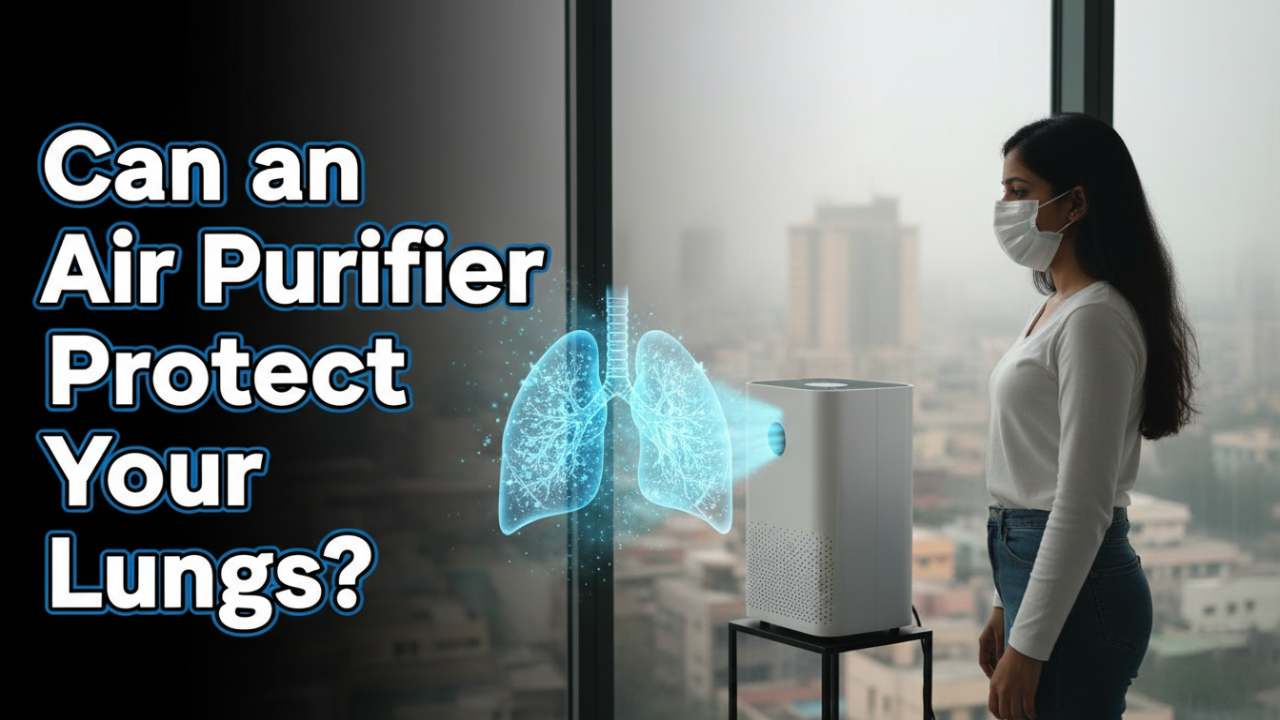Can Air Purifiers Protect You from Smog and Dust Allergies?
Verified By Dr. Ritisha Bhatt | 21-Oct-2025
Air pollution and dust allergies are growing concerns, especially in urban areas like Noida, Delhi NCR, and other metropolitan cities. With smog episodes becoming more frequent and air quality deteriorating rapidly, many individuals experience respiratory issues, eye irritation, and general discomfort. Dr. Ritisha Bhatt, Pulmonary & Sleep Medicine Expert at Kailash Hospital, explains how air purifiers can help manage these conditions, improve indoor air quality, and reduce the risk of smog and dust-related allergies.
Table of Content
Smog is a mixture of pollutants, dust, smoke, and chemical substances suspended in the air. It primarily consists of particulate matter (PM2.5 and PM10), nitrogen oxides, sulfur dioxide, and volatile organic compounds (VOCs).
Dust allergies, on the other hand, are caused by exposure to airborne particles such as pollen, dust mites, mold spores, and animal dander. These allergens can trigger sneezing, congestion, cough, watery eyes, and asthma attacks in sensitive individuals.
According to Dr. Bhatt, “Smog and dust allergies are closely related. Particulate matter in polluted air often carries allergens, making symptoms worse during winter and peak pollution seasons.”
1. Irritation of Airways
Fine particles in smog settle on the mucous membranes of the respiratory tract, causing irritation and inflammation. This can lead to sore throat, cough, and difficulty breathing.
2. Triggering Allergic Reactions
Airborne dust and pollen can stimulate the immune system, causing histamine release. This results in sneezing, itchy eyes, nasal congestion, and throat irritation.
3. Worsening Asthma Symptoms
Individuals with pre-existing respiratory conditions, including asthma, may experience frequent attacks, wheezing, and chest tightness when exposed to polluted air.
4. Long-Term Health Risks
Chronic exposure to smog and dust increases the risk of bronchitis, COPD, cardiovascular diseases, and reduced lung function over time.
Also read: Unlocking Relief: How to Relieve Chest Tightness and Shortness of Breath
Air purifiers are devices designed to filter harmful particles, allergens, and pollutants from indoor air. Their effectiveness depends on the type of filter, room size, and proper usage.
Types of Air Purifiers
1. HEPA Filters (High-Efficiency Particulate Air)
- Remove up to 99.97% of particles ≥0.3 microns
- Effective against dust, pollen, pet dander, and some smoke particles
2. Activated Carbon Filters
- Absorb odors, gases, and chemical pollutants
- Useful for volatile organic compounds (VOCs) and smoke
3. Ionizers and Electrostatic Filters
- Charge particles in the air to make them settle
- Can reduce airborne particles but may generate small amounts of ozone
4. UV-C Light Purifiers
- Kill bacteria, viruses, and mold spores
- Often combined with HEPA filters for comprehensive protection
1. Reduction of Particulate Matter
Air purifiers significantly reduce PM2.5 and PM10 particles, which are responsible for smog-related respiratory irritation.
2. Allergy Relief
By filtering out dust mites, pollen, and mold spores, air purifiers can reduce allergic reactions, including sneezing, congestion, and itchy eyes.
3. Asthma Symptom Management
Cleaner air reduces airway inflammation and helps asthma patients experience fewer attacks.
4. Improved Sleep Quality
Exposure to allergens at night can disturb sleep. Air purifiers maintain a clean and allergen-free bedroom, promoting better rest.
5. Protection for Vulnerable Groups
Children, the elderly, and people with chronic respiratory conditions benefit the most from continuous use of air purifiers in homes, schools, and offices.
While air purifiers offer several benefits, they are not a complete solution:
- They only clean indoor air, so outdoor exposure still poses risks.
- Devices must be appropriately sized for the room for maximum efficiency.
- Regular maintenance, such as filter replacement, is essential.
- Ionizers may generate ozone, which can irritate the lungs if not properly designed.
Dr. Bhatt cautions, “Air purifiers should be considered a part of a comprehensive strategy, including masks, reduced outdoor exposure, and preventive health measures.”
Also read: The Choking City: How Air Pollution is Fueling Delhi NCR's Asthma Epidemic
1. Limit Outdoor Exposure
Avoid outdoor activities during peak smog or pollen seasons. Monitor Air Quality Index (AQI) and plan outdoor activities accordingly.
2. Wear Masks
Use N95 or N99 masks outdoors to filter particulate matter and allergens.
3. Maintain Indoor Cleanliness
- Dust and vacuum regularly with HEPA-filtered vacuums
- Wash bedding weekly to remove dust mites
- Keep windows closed during high pollution periods
4. Hydration and Diet
Stay hydrated and include antioxidant-rich foods to support respiratory health.
5. Medical Care
- Use prescribed medications for allergies and asthma
- Consult a pulmonologist if symptoms persist or worsen
- Consider allergy testing to identify specific triggers
A study conducted in urban homes during smog season showed that HEPA air purifiers reduced indoor PM2.5 levels by over 60% within a few hours. Participants reported:
- Reduced coughing and sneezing
- Improved sleep quality
- Less throat irritation and congestion
Dr. Bhatt adds, “Consistent use of air purifiers, combined with other preventive strategies, significantly improves quality of life for allergy and asthma patients.”
When selecting an air purifier, consider:
- Room Size: Ensure the purifier can handle the area where it will be used
- Filter Type: HEPA + activated carbon combination is ideal for smog and dust
- CADR (Clean Air Delivery Rate): Higher CADR means faster purification
- Noise Level: Important for bedrooms and study areas
- Maintenance: Easy filter replacement and cost-effective operation
Also read: Navigating India's COVID-19 Resurgence: Your Top Questions Answered by a Leading Pulmonologist
At Kailash Hospital, our Pulmonary & Sleep Medicine experts emphasize a holistic approach to managing pollution and dust-related health issues:
- Regular monitoring of lung function for patients with chronic conditions
- Preventive care including vaccinations and lifestyle counseling
- Guidance on indoor air quality management, including air purifiers
- Personalized advice for children, elderly, and sensitive patients
Dr. Ritisha Bhatt concludes, “Air purifiers are a valuable tool in reducing exposure to harmful pollutants indoors, but they should be part of a comprehensive strategy that includes masks, lifestyle modifications, and medical guidance.”
Smog and dust allergies are serious health concerns in urban environments. While air purifiers cannot eliminate all risks, they significantly reduce indoor pollutants, providing relief from allergies, asthma triggers, and respiratory irritation.
By combining the use of air purifiers with preventive strategies, such as limiting outdoor exposure, wearing protective masks, maintaining cleanliness, and consulting healthcare professionals, individuals can protect their respiratory health effectively.
At Kailash Hospital, our Pulmonary & Sleep Medicine team is dedicated to helping patients navigate smog and dust-related health challenges, ensuring clean air, healthier lungs, and better quality of life.



 +91-9711918451
+91-9711918451
 international.marketing@kailashhealthcare.com
international.marketing@kailashhealthcare.com






